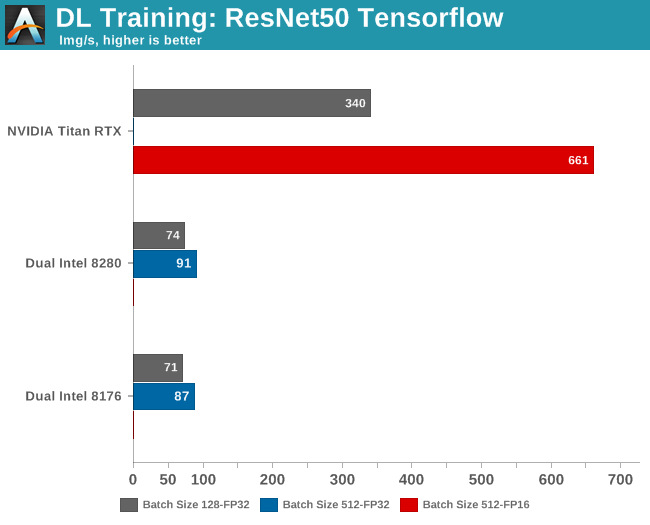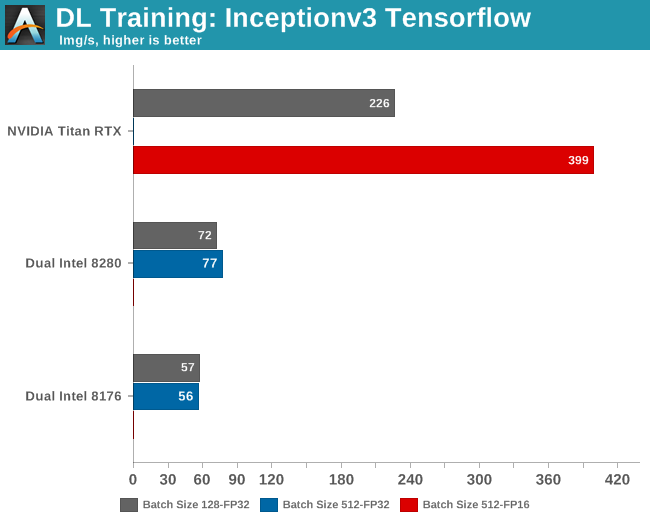Intel's Xeon Cascade Lake vs. NVIDIA Turing: An Analysis in AI
by Johan De Gelas on July 29, 2019 8:30 AM ESTConvolutional Neural Network Training
For a long time, the way forward in CNNs was to increase the number of layers – increasing the network depth for "even deeper learning". As you can probably guess, this resulted in diminishing returns and made the already complex neural networks even harder to tune, leading to more training errors.
The ResNet-50 benchmark is based upon residual networks (hence ResNet), which have the merit of fewer training errors as the network gets deeper.
Meanwhile, as a little bit of internal housekeeping here, for regular readers I’ll note that the benchmark below is not directly comparable to the one that Nate ran for our Titan V review. It is the same benchmark, but Nate ran the standard ResNet-50 training implementation that is included in NVIDIA's Caffe2 Docker image. However, since my group is mostly using TensorFlow as a deep learning framework, we tend to with stick with it. All benchmarking
tf_cnn_benchmarks.py --num_gpus=1 --model=resnet50 --variable_update=parameter_server
The model trains on ImageNet and gives us throughput data.

Several benchmarks are missing, and for a good reason. Running a batch size of 512 training samples at FP32 precision on the Titan RTX results in an "out of memory" error, as the card "only" has 24 GB available.
Meanwhile on the Intel CPUs, half precision (FP16) is not (yet) available. AVX512_BF16 (bfloat16) will be available in the Cascade Lake's successor, Cooper Lake.
It has been observed that using a larger batch can causes significant degradation in the quality of the model, as measured by its ability to generalize. So although larger batch sizes (512) make better use of the massive parallelism inside the GPU, the results with the lower batch sizes (128) are useful too. The accuracy of the model loses only a few percent, but in many applications a loss of even a few percent is a significant.
So while you could quickly conclude that Titan RTX is seven times faster than the best CPU, it is more accurate to say that it is between 4.5 and 7 times faster depending on the accuracy you want.
Inception (v3)
Inception is based upon GoogLeNet. Contrary to the earlier dense neural networks, GoogLeNet was based on the idea that neural networks can be much more efficient if you do not connect every neuron in every layer to the next one. The downside of this optimization is that this results in sparse matrices, which are far from optimal for the typical SIMD/GPU architectures and their BLAS software.
Overall, the main goal of "Inception" was to turn GoogLeNet into a neural network that would result in dense matrix multiplication. Or in other words, something that ran a lot faster on a GPU or SIMD hardware. In the end, version 3 of this neural network has proven to be even more accurate than ResNet-50.

This time, the GPU is about 3 to 5 times faster, depending on the batch size. It is interesting to note that ResNet is more GPU friendly than Inception. But of course, this only matters for academics and hardware enthusiasts.
Software engineers who have to build AI models will however remark quickly that a $3k GPU is at least 3 times faster than a $20k+ (or worse) CPU configuration. And they are right: there is no contest. When it comes to Convolutional Neural Networks, the rock stars of AI, a good GPU (with a good software stack) will mop the floor with even the best CPUs. In a datacenter you typically encounter the NVIDIA Tesla GPUs which cost around four times more, but offer anywhere from 1.5x to 2x the performance of similar Titan cards.










56 Comments
View All Comments
Drumsticks - Monday, July 29, 2019 - link
It's an interesting, valuable take on the challenges of responding to many of the ML workloads of today with a general purpose CPU, thanks! A third party review of Intel's latest against Nvidia, and even throwing AMD in to the mix, is pretty helpful as the two companies have been going at it for a while now.Intel has a lot of stuff going that should make the next few years quite interesting. If they manage to follow through on the Nervana Coprocessor/NNP-I that Toms talked about, or on their discrete GPUs, they'll have a potent lineup. The execution definitely isn't guaranteed, especially given the software reliance these products will have, but if Intel really can manage to transform their product stack, and do it in the next few years, they'll be well on their way to competing in a much larger market, and defending their current one.
OTOH, if they fail with all of them, it'll definitely be bad news for their future. They obviously won't go bankrupt (they'll continue to be larger than AMD for the foreseeable future), but it'll be exponentially harder if not impossible to get back into those markets they missed.
JohanAnandtech - Monday, July 29, 2019 - link
Thanks! Indeed, Nervana coprocessors are indeed Intel's most promising technology in this area.p1esk - Monday, July 29, 2019 - link
No one in their right mind would think "gee, should I get CPU or GPU for my DL app?" More concerning for Intel should be the fact that I bought a Threadripper for my latest DL build.Smell This - Monday, July 29, 2019 - link
You gotta Radeon VII ?I'm thinking Intel, and to a lesser extent, nVidia, is waiting for the next shoe(s) to drop in **Big Compute** --- Cascade Lake has been left at the starting gate.
An AMD Radeon Instinct 'cluster' on a dense specialized 'chiplet' server with hundreds of CPU cores/threads is where this train is headed ...
JohanAnandtech - Monday, July 29, 2019 - link
Spinning up a GPU based instance on Amazon is much more expensive than a CPU one. So for development purposes, this question is asked.p1esk - Tuesday, July 30, 2019 - link
Then you should be answering precisely that question: which instance should I spin up? Your article does not help with that because the CPU you test is more expensive than the GPU.JohnnyClueless - Monday, July 29, 2019 - link
Really surprised Intel, and to a lesser extent AMD, are even trying to fight this battle with nVidia on these terms. It’s a lot like going to a gun fight and developing an extra sharp samurai sword rather than bringing the usual switchblade knife. The sword may be awesome, but it’s always going to be the wrong tool for the gun fight.IMO, a better approach to capture market share in DL/AI/HPC might be to develop a low core count (by 2019 standards) CPU that excelled at sequential single threaded performance. Something like 6-10 GHz. That would provide a huge and tangible boost to any workload that is at least partially single core frequency limited, and that is most DL/AI/HPC workloads. Leave the parallel computing to chips and devices designed to excel at such workloads!
Eris_Floralia - Monday, July 29, 2019 - link
Still living in early 2000s?FunBunny2 - Monday, July 29, 2019 - link
"Something like 6-10 GHz. "IIRC, all the chip tried to get near that, but couldn't. it's not nice to fool Mother Nature.
Santoval - Monday, July 29, 2019 - link
"Something like 6-10 GHz."Google "Dennard scaling" (which ended in ~2005) to find out why this is impossible, at least with silicon based MOSFET transistors (including the GAA-FET based ones of the next decade). Wikipedia has a very informative page with multiple links to various sources for even more. The gist of the end of Dennard scaling is that single core clocks higher than ~5 GHz (at a reasonable TDP of up to ~100W) are explicitly forbidden at *any* node.
When Dennard scaling ended -in combination with the slowing down of Moore's Law- there was another, related consequence : Koomey's law started to slow down. Koomey's law is all about power efficiency, i.e. how many computations you can extract from each Wh or kWh.
Before the early 2000s the number of computations per x unit of energy doubled on average every 1.57 years. In 2011 Koomey himself re-evaluated his law and got an average doubling of computations every 2.6 years for the previous decade, a substantial collapse of power efficiency. Since 2011 Koomey's law has obviously slowed down further.
To make a long story short Moore's law puts a limit to the number of transistors we can fit in each mm^2, and that limit is not too far away. Dennard scaling once allowed us to raise clocks with each new node at the same TDP, and this is ancient history in computing terms. Koomey's law, finally, puts a limit to the power efficiency of our CPUs/GPUs, and this continues to slow down due to the slowing down of Moore's Law (when Moore's Law ends Koomey's law will also end, thus all three fundamental computing laws will be "dead").
Unless we ditch silicon (and even CMOS transistors, if required) and adopt a new computing paradigm we will have neither 6 - 10 GHz clocked CPUs in a couple of decades nor will we able to speed up CPUs, GPUs and computers at all.